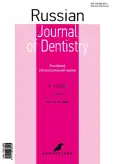Experimental in vitro study of the adhesive strength of universal adhesives for orthodontic bracket fixation
- Authors: Nemer A.S.1, Razumova S.N.1, Brago A.S.1, Artemova O.A.1
-
Affiliations:
- Peoples’ Friendship University of Russia
- Issue: Vol 29, No 2 (2025)
- Pages: 143-149
- Section: Experimental and Theoretical Investigations
- Submitted: 28.01.2025
- Accepted: 17.03.2025
- Published: 29.04.2025
- URL: https://rjdentistry.com/1728-2802/article/view/646875
- DOI: https://doi.org/10.17816/dent646875
- ID: 646875
Cite item
Abstract
Background: An optimal adhesive system must ensure quick and easy application while also demonstrating adequate adhesive strength that does not change over time. The development of adhesive systems continues, and each currently available adhesive system has advantages and disadvantages. During orthodontic treatment, practitioners must not only address malocclusion and minimize damage to intact tooth tissues, but also prevent dental caries. Despite ongoing advancements in adhesive systems, there are no studies that confirm the long-term durability of 8th generation systems containing the 3D-SR monomer.
Aim: To assess the adhesive strength of metal braces when using the Tokuyama Universal Bond II adhesive system (Tokuyama Dental, Japan) in a laboratory setting before and after thermal cycling with and without the SHIELD FORCE PLUS sealant (Tokuyama Dental, Japan).
Methods: The study included 60 intact extracted teeth without signs of dental caries and extensive restorations. There were four groups of samples. Group 1 included 15 samples with metal braces placed without a sealant and thermal cycling; Group 2 included 15 samples with metal braces placed without a sealant, with thermal cycling; Group 3 included 15 samples with metal braces placed with a sealant, without thermal cycling; and Group 4 included 15 samples with metal braces placed with a sealant and thermal cycling.
Results: Thermal cycling decreased shear adhesive strength: in samples with brackets placed without the SHIELD FORCE PLUS sealant, the adhesive strength before thermal cycling was higher (4.10±0.96 MPa) than after thermal cycling (3.44±1.03 MPa). The SHIELD FORCE PLUS sealant significantly increased shear adhesive strength: in samples with brackets placed with the sealant, the adhesive strength in the group without thermal cycling was higher than in the group after thermal cycling (3.71±0.61 MPa and 2.58±0.76 MPa, respectively; p=0.0005).
Conclusion: The statistical analysis revealed no significant differences (p >0.05) in the adhesive strength of braces placed with and without the sealant. Thermal cycling significantly (p ≤0.05) reduces the adhesive strength of braces placed with and without the sealant. The sealant does not reduce the adhesive strength of braces; thus, they can be used to prevent dental caries, decrease tooth sensitivity, and improve the mineral composition of tooth tissues.
Full Text
About the authors
Ameera S. M. Nemer
Peoples’ Friendship University of Russia
Author for correspondence.
Email: dr.ameera.nemer@gmail.com
ORCID iD: 0000-0002-7034-0831
Russian Federation, Moscow
Svetlana N. Razumova
Peoples’ Friendship University of Russia
Email: razumova-sn@rudn.ru
ORCID iD: 0000-0002-9533-9204
SPIN-code: 6771-8507
MD, Dr. Sci. (Medicine), Professor
Russian Federation, MoscowAngela S. Brago
Peoples’ Friendship University of Russia
Email: anzhela_bogdan@mail.ru
ORCID iD: 0000-0001-8947-4357
SPIN-code: 2437-8867
MD, Cand. Sci. (Medicine), Associate Professor
Russian Federation, MoscowOksana A. Artemova
Peoples’ Friendship University of Russia
Email: artemova-oa@rudn.ru
ORCID iD: 0000-0003-1353-2957
SPIN-code: 2779-9801
MD, Cand. Sci. (Medicine)
Russian Federation, MoscowReferences
- Liang J, Peng X, Zhou X, et al. Emerging applications of drug delivery systems in oral infectious diseases prevention and treatment. Molecules. 2020;25(3):516. doi: 10.3390/molecules25030516 EDN: FLRRAS
- Tabet MAK, Razumova SN, Brago AS, et al. Different methods of professional oral hygiene. Literature review. Medical Alphabet. 2022;(7):15–19. doi: 10.33667/2078-5631-2022-7-15-19 EDN: YCIIXN
- Guo J, Li L, Guan G, e al. Oral health knowledge and practice among orthodontic clients in China and New Zealand. Can J Dent Hyg. 2020;54(3):124–132.
- Koko M, Takagaki T, Abdou A, et al. Effects of the ratio of silane to 10-methacryloyloxydecyl dihydrogenphosphate (MDP) in primer on bonding performance of silica-based and zirconia ceramics. J Mech Behav Biomed Mater. 2020;112:104026. doi: 10.1016/j.jmbbm.2020.104026 EDN: VKPVYS
- Nemer ASM, Brago AS, Razumov NM, et al. Investigation of adhesive shear strength of universal adhesives for fixing ceramic braces. Medical Alphabet. 2023;(30):14–18. doi: 10.33667/2078-5631-2023-30-14-18 EDN: ZLAARJ
- Tang C, Ahmed MH, Yao C, et al. Experimental two-step universal adhesives bond durably in a challenging high C-factor cavity model. Dent Mater. 2023;39(1):70–85. doi: 10.1016/j.dental.2022.11.021 EDN: ZDPCIJ
- AlSamak S, Alsaleem NR, Ahmed MK. Evaluation of the shear bond strength and adhesive remnant index of color change, fluorescent, and conventional orthodontic adhesives: An in vitro study. Int Orthod. 2023;21(1):100712. doi: 10.1016/j.ortho.2022.100712 EDN: DBVUAW
- Perdigão J, Araujo E, Ramos RQ, et al. Adhesive dentistry: Current concepts and clinical considerations. J Esthet Restor Dent. 2021;33(1):51–68. doi: 10.1111/jerd.12692 EDN: BMOZOP
- Tahmasbi S, Badiee M, Modarresi M. Shear bond strength of orthodontic brackets to composite restorations using universal adhesive. J Dent (Shiraz). 2019;20(2): 75–82. doi: 10.30476/DENTJODS.2019.44927
- Khasan AM, Kosyreva TF, Tuturov NS. The review of studies on the bonding of metal brackets to tooth enamel and ceramics. Stomatologija dlja vseh. 2023;(1):32–37. doi: 10.35556/idr-2023-1(102)32-36 EDN: FRYMAE
- Brown T, Kee E, Xu X, et al. Shear bond strength of orthodontic brackets bonded to high-translucent dental zirconia with different surface treatments: An in vitro study. Int Orthod. 2024;22(1):100822. doi: 10.1016/j.ortho.2023.100822 EDN: DWHQRC
- Suzuki M, Takamizawa T, Hirokane E, et al. Bond durability of universal adhesives to intact enamel surface in different etching modes. Eur J Oral Sci. 2021;129(2):e12768. doi: 10.1111/eos.12768 EDN: TLJKIJ
Supplementary files












